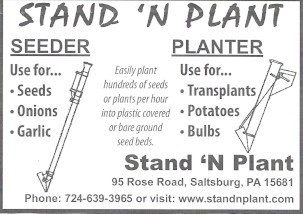Many customers will not know the difference between a natural greenhouse and a commercial one, except that they will notice your plants look healthier and your vegetables taste better. It is your responsibility to educate them about the reasons why your plants grow better, and your produce is more nutritious. The more knowledgeable your customers perceive you to be, the more often they will seek you out and buy your products.

Early in the spring, some customers will ask for varieties that are not frost hardy and, if yours are not quite ready, will buy them elsewhere. Whenever you have the opportunity, explain the risks of frost to warm-season plants and let customers know which plants you will have ready when it will be safe to plant them. Many will return to buy those plants when the weather is warmer. Customers who buy frost-sensitive plants early should be encouraged to cover plants during expected frosts or transplant them into larger pots to provide additional space for root growth until planting time. This article explains how to find the correct planting time for plants and vegetables.
Customers appreciate information on appropriate planting times and soil conditions required by the varieties they grow. Explain the difference between air and soil temperature requirements of plants. Many warm-weather plants can be planted in the soil as soon as the danger of frost is past. Some plants, like basil and cucumbers, require warm soil temperatures as well. In spring, daytime air temperatures warm up more quickly than the soil. Long rainy periods will slow the ability of the soil to warm, causing the roots of cold-sensitive plants and some seeds to rot. Tell customers about the cops that require warmer soil conditions.
You begin the education process when you recommend soil and planting conditions. Soon customers will hope you can answer questions on plant size and shape, growing requirements, whether it is an annual or perennial, and whether it is frost hardy. Some people will need to know if its roots will be easily damaged by transplanting; when the plant requires sun or shade; or what type of flower, herb, fruit, or vegetable it will produce. Repeat customers will have questions about insect and animal control. Every time you can provide your customers with answers, you will increase their motivation to buy from you. Chain stores and most garden centers are staffed with people who have little information about the things they sell. Customers are left to fend for themselves and sometimes buy plants unsuited for their needs.
Signs can be used to educate customers. With a carefully developed system of signs, people find the plants they need. Labels can be used to identify varieties and provide growing information. When I find a short article on insect control or other topics of interest, I copy it and post it on my signboard. Or you can post a link to it on your blog or website.
When selling plant varieties that require special care, it is important to tell your customers how to plant, water, and fertilize them properly. Providing written instructions is helpful to customers because verbal instructions are often forgotten in the hectic shopping experience. Specialty plants that will remain in containers or hanging baskets are sold with care tags, which I make myself and laminate with clear contact paper. They provide the basic care each variety requires. Seeing a care tag attached to the container attracts customers’ attention and promotes sales. You also will need to tell your wholesale customers how to take care of your plants until they are sold.
No matter how many signs you have, there will be questions that signs can’t answer. Because your plants are so healthy, your vegetables taste so good, and you have attractive and informative signs, customers will assume you are knowledgeable about almost everything related to plants and vegetables.
Customers will ask you about germinating, growing, planting, dividing, and caring for plants. They will tell you the conditions under which they want plants to grow and ask if you have plants that will grow there. I keep my master seed and plant list, my germination schedule, and copies of seed catalogs from which I order, near by. A great many questions can be answered from those materials.
Customers will bring you dead, dying, or infected plant samples, to find out what is wrong with them. You may or may not know the answers, but you will need to make sure you don’t transfer their infestations to your healthy plants. Have a supply of clean plastic bags or glass jars nearby in which to place infected plants while examining them.
Some customers don’t know the differences between varieties. They know only that they want a certain type of vegetable, and they want it to taste or look good and produce well. I selectively promote varieties that I believe will perform better for my customers. I consider it my responsibility to recommend varieties that will improve their chances of success and keep them gardening. You too can help educate your customers so they will have a more productive growing season.
“What types of plants do deer not eat?” is one of the most common questions I am asked. Because I cannot remember, I download the list for my area from my state university
Extension service’s website and always have one available for my customers to read.
Whatever creatures are indigenous to your area will try to eat your customers’ plants. You should be ready to provide whatever information is available on the subject or direct them to a place where they can find it for themselves. Rabbits, groundhogs, birds, and slugs also are frequent pests. A light dusting of finely ground limestone usually discourages most four-legged critters until the plants become large enough to be less interesting to animals seeking tender spring shoots. Animals don’t like the taste and gritty texture of lime dust. For larger critters, nets, fences, and dogs are usually necessary. Customers in small towns and rural areas are increasingly turning to electrified and double fences to protect vegetable gardens and precious flower beds. For insect control, I recommend the same solutions I use in my greenhouse—certified organic controls, primarily insecticidal soap, pyrethrum, rotenone, and Bacillus thuringiensis. Whatever critter and insect control methods work for you, your customers will want to know about them.
Some questions and problems will need to be directed to Extension educators or horticulturists at the local university. It is wise to have a list of names and phone numbers of people to whom you can refer customers with their unanswered questions.
Gini Coover is the author of The Natural Greenhouse, Growing Plants and Food for Profit. She has grown greenhouse plants and vegetables for over 30 years, selling retail and wholesale from her greenhouse.
Related Articles & Free Email Newsletter Sign Up
Common Sense Insect and Disease Control in a Natural Greenhouse
How to Grow Vegetables and Fruit in a Hot Summer Greenhouse
How to Market Naturally Raised Plants and Vegetables




Comment here